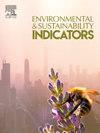土壤健康和管理评估试剂盒(SOHMA kit®):开发和验证农场应用
IF 5.6
Q1 ENVIRONMENTAL SCIENCES
引用次数: 0
摘要
土壤健康是土壤长期多功能性、维持作物产量和增强作物抵御气候变化能力的基础。然而,土壤健康评估往往复杂、昂贵和耗时,这是农民采用这些评估的障碍。因此,我们假设一种由关键指标组成的简化的农场土壤健康评估方法可以有效地检测不同土地管理制度下土壤健康的变化。本研究旨在(i)验证土壤健康与管理评估试剂盒(SOHMA Kit®)作为农场土壤健康评估的可靠工具,(ii)将其性能与标准实验室方法进行比较,以及(iii)评估其检测覆盖作物引起的土壤健康改善的灵敏度。这项验证研究是在巴西热带稀树草原(Cerrado生物群系)的两个长期田间试验中进行的,在那里评估了不同的覆盖作物系统。经过广泛的工作,包括文献综述,选择和开发的方法,SOHMA试剂盒®被创建。SOHMA KIT®将七个土壤健康指标从物理(渗透,团聚体稳定性,土壤结构视觉评价- VESS),化学(pH)和生物(过氧化氢酶,大型动物,生物团聚体)组成土壤健康指数(SHI)。在验证试验中,结果表明,在多样化种植制度下,SHI增加了35%左右。SOHMA KIT®与标准方法在关键指标(例如,浸润:r = 0.71,团聚稳定性:r = 0.40, pH: r = 0.88)上观察到很强的相关性。尽管该工具包具有可移植性和成本效益,但它有一些局限性,例如建议用户接受评估视觉指标的基本培训,并且评估仅侧重于表土层。然而,SOHMA KIT是用户友好和可扩展的,是农场决策,再生农业和大规模土壤健康监测的宝贵工具。本文章由计算机程序翻译,如有差异,请以英文原文为准。

Soil health and management assessment kit (SOHMA KIT®): Development and validation for on-farm applications
Soil health is a foundation for long-term soil multifunctionality, sustaining crop yields and enhancing crop resilience to climate change. Nevertheless, soil health assessments are often complex, costly and time-consuming, which acts as a barrier to farmers adopting them. Thus, we hypothesized that a simplified, on-farm approach to evaluate soil health, composed by key indicators, could effectively detect changes in soil health across different land management systems. This study aimed to (i) validate the Soil Health and Management Assessment Kit (SOHMA KIT®) as a reliable tool for on-farm soil health assessment, (ii) compare its performance with standard laboratory methods, and (iii) assess its sensitivity for detecting soil health improvements induced by cover crops. The validation study was conducted in two long-term field experiments in the Brazilian savanna (Cerrado biome), where different cover crop systems were evaluated. After extensive work involving literature review, selection and development of methods, the SOHMA KIT® was created. The SOHMA KIT® integrates seven soil health indicators from physical (infiltration, aggregate stability, Visual Evaluation of Soil Structure - VESS), chemical (pH), and biological (catalase enzyme, macrofauna, biogenic aggregates) components into a Soil Health Index (SHI). In the validation tests, results showed that the SHI increased around 35 % in diversified cropping systems. Strong correlations between SOHMA KIT® and standard methods were observed for key indicators (e.g., infiltration: r = 0.71, aggregate stability: r = 0.40, pH: r = 0.88). Despite its portability and cost-effectiveness, the toolkit has some limitations, such as it is recommended that users have a basic training for assessing visual indicators, and the assessment is focused only on topsoil layers. However, the SOHMA KIT® is user-friendly and scalable, being a valuable tool for on-farm decision-making, regenerative agriculture, and large-scale soil health monitoring.
求助全文
通过发布文献求助,成功后即可免费获取论文全文。
去求助
来源期刊

Environmental and Sustainability Indicators
Environmental Science-Environmental Science (miscellaneous)
CiteScore
7.80
自引率
2.30%
发文量
49
审稿时长
57 days
 求助内容:
求助内容: 应助结果提醒方式:
应助结果提醒方式:


